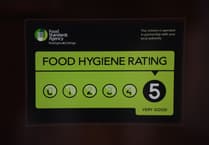PA23/02727: PLANS for the proposed repowering and extension of Cold Northcott Windfarm, including the removal of all existing turbines and replacing with up to 22 wind turbines up to 115 metres to tip with associated works on land at Cold Northcott, St Clether, Cornwall has been met by concerns from residents.
The application, has been made by Mr R M Quinn of Cold Northcott Windfarm Ltd.
Tresmeer Parish Council said in its consultation response: “Councillors discussed this application in depth. Mr Wonnacott (Planning agent) and Mr M Quinn (Applicant) attended the meeting to provide further information and to answer any questions.
“A query was made regarding low flying aircraft as the area is often in use for low level flying by the MoD. According to Mr Wonnacott, consultations have been held with National Air Traffic Control and the MoD have been notified.
“The turbines will also be fitted with infra-red lights visible to aircraft systems. Councillors queried the height of the turbines as they will be significantly higher than the turbine at Pipers Pool (approx. 3.9 miles from Cold Northcott).
“Mr Wonnacott and Mr Quinn explained that the size of the turbines makes it less likely that birds and bats would be affected. The higher a turbine is the more electricity it generates. Mr Wonnacott also highlighted community benefits such as the opportunity for local groups to invest in the project.
“A query was raised about the amount of construction work required, Mr Quinn mentioned that the site already has a connection to the National Grid. At the end of the discussion no objections were made by councillors. Several members of the public offered their support to the application.”
One objector, Mr Joseph Stretton, said: “I am writing to object to the planning application PA23/02727 - proposed repowering of the Cold Northcott Windfarm. I have reviewed the thorough documents and regrettably I am unable to support the proposal in its current form. I have outlined my objections and considerations below.
“Visual Impact / effect on appearance of the area / safeguarding of the countryside: I believe the proposed development to be of sufficient scale to not comply with Policy 23 of the Cornwall Local Plan in so far as it will not preserve or sustain the local character of the areas as referenced within the application.
“This application is of a scale and mass which does not respect the landscapes character. When added to the surrounding wind turbines it compounds the impact which already exists. Could the council / applicant consider lower numbers of larger turbines?
“Encirclement, Proximity, and number to my dwelling: My dwelling is close to the centre of the proposed development and as such the plans indicate that there will 11 new wind turbines (Turbine numbers 5, 6, 7, 9, 10, 11, 12 14, 15 16, 20) installed within 1 km of my dwelling.
“Furthermore, the plans as they stand will encircle my dwelling (from N round through S to the W), This I believe goes against the intent of policy 14 of the Cornwall local plan in so far as the effects will be cumulative at my dwelling and have an overbearing effect. Could the council / applicant consider lower numbers of larger turbines?
“Noise: Whilst noise monitoring did not take place at my dwelling it was recorded within my settlement at Craigmore Cottage. Whilst some mitigation is offered in the planning application for my dwelling it does not capture turbines 5, 6, and 7 which are upwind of the prevailing wind direction, nor does it consider the summative effects on the dwellings in Cold Northcott settlement.
“This effect, I believe to be against policy 14. I would request the council to consider additional mitigation applied to all turbines surrounding my dwelling to ensure that noise levels fall within the required levels.
“Furthermore, I request additional studies are undertaken to assess the cumulative effect of the noise and especially lower frequency noise will have on the local population’s health and mitigate the effects. Noise during construction should also be a factor and I request this is stipulated to only take place during the daytime within the working week.
“Flicker and sun glint: As covered by the documentation submitted flicker has been predicted to affect my dwelling, however no commitment to mitigating these effects are contained within the application.
“I request the council makes a condition of planning the control measures must be implemented from the commissioning of each turbine rather than place the burden of proof and action of the dwelling owners. From the submitted plans I believe my dwelling has been under predicted, as well as T11, 14, 15, the map provided (C13-4) suggests that we will also experience the effect when conditions allow from T6 and possibly 5. This is due the encirclement of my dwelling and again I would ask the council to make a condition of planning the forced mitigation of these effects, and due consideration to the cumulative effects. With the locations of the proposed turbines from my dwelling I would also like the council to consider sun glint and its effect, both features I believe have not been sufficiently mitigated and go against Policy 14.
Government guidance: Whilst I note not a consideration for a final planning decision, I would draw the council’s attention to the fact that there has been no consultation or engagement during the application process to offer community engagement and benefits.
“This goes against the Department for Business, Energy, and Industrial Strategy’s good practice guidance (Community Engagement and Benefits from Onshore Wind Developments: good practice guidance for England (publishing.service.gov.uk)), I further note that said department is currently consulting on improved rewards and benefits for communities backing onshore wind farms.
“ I would ask the applicant to engage with this process to gather increased local support, but until this happens, I would ask the council to consider that the applicant is not following the guidance deemed best practice by Government.
“Cumulative: Finally, it is the cumulative effects of the number of turbines, their encirclement of my dwelling and the number of adverse effects which I base my objections upon.
“The Cold Northcott Wind farm has been operational for a significant number of years, and now it seems right to let the landscape recover for a period to better enhance the local area. I am of course willing to engage with the applicant / council and would be happy to revisit this position if sufficient mitigation measures are offered. Until that time, I believe this proposal, in its current form, should be declined.”
Mr Martin Wright said: “Stance - Neutral, with reservations. Two areas edged red but unnumbered on the location plan, but near ‘ET16’ abut registered common land, under unit No. CL373 and known as Tremeer Common - Napp’s Moor on location plan. However, access is over the registered common land.
“Under section 38 of the Commons Act 2006 there is a general prohibition on works on common land without the consent of the appropriate national authority, the Planning Inspectorate acting on behalf of the Secretary of State for Environment, Food and Rural Affairs.
“The applicant is advised to seek consent from the Planning Inspectorate if the access across the registered common land is to be improved/there are resurfacing works.
“If the local planning authority is minded to approve the application, the applicant should be aware that if the consent of the Planning Inspectorate IS NOT obtained for any works on common land, under section 41 of the Commons Act 2006 where section 38 applies, ANY PERSON may apply to the county court in whose area the land is situated for the removal of the works and restoration of the land to the condition it was in before the works were carried out.”
Mr David Crisp commented: “There must be an existing infrastructure already in place to make it a sensible proposal to update this existing windfarm rather than to create another solar farm or a new windfarm on a different site.I do feel the modern turbines, for example, the one at Pipers Pool must be more efficient and produce more generated power than the old twin blade version.
“As long as the power is used not sent to ground it is a sensible development. Possible concessionary rates could be offered to householders within a given radius.”
There has also been an objection from Joint Radio Company UK.
They said: “There is an exclusion zone around most Base Station sites of 500m, i.e. no development is permitted. This will be evaluated on a case-by-case basis for smaller turbines.
“Unfortunately, part (or all) of the proposed development breaches one or more of these limits.
“The affected links are: 460MHz Telemetry and Telecontrol: JESWMS1 to JESWMO9 >1GHz Microwave Point to Point:N/A
“Therefore JRC objects to the proposed development. Unfortunately, since these links form part of our critical national infrastructure, no details apart from the link identifiers can now be supplied, due to previous breaches in confidentiality.
“However, JRC are still willing to work with developers in order to clear as many turbines as possible, including those that may initially fall within the coordination zone. For more information about what to do next, please contact us using the link at the bottom of this email. The JRC objection shall be withdrawn after simple analysis shows no issues; when a satisfactory coordination has been achieved and the zone of protection is implemented; or when an appropriate mitigation agreement is in place.”
PA23/08664: A certificate of lawfulness for a proposed development, namely the removal of existing signage and branding, ATM (automated teller machine), and internal unfixed structures in association with the decommissioning of a bank in Bodmin has been refused by Cornwall Council.
The application was made on behalf of Lloyds Bank, who are seeking to close their branch on Fore Street, in Bodmin, on June 24, 2024.
In the application, the applicant detailed works which would be required upon the closure of the Lloyds Bank branch, a listed building.
The listing for the building reads: “This Lloyds bank is a Grade II Listed Building; listed on January 7, 1994 (no. 1195268) as follows: SX0767 FORE STREET 629-1/2/60 (South side) Lloyds Bank. GV II Bank. c1870. Rusticated freestone with plinth, segmental, round and flat arches all with stepped keyblocks, mid-floor moulded entablature with fascia, moulded architrave strings and torus-moulded parapet entablature surmounted by 4-bay balustraded and ashlar parapet.
“Double-depth plan. 2 storeys; 4-bay 4-window-range front. Flat arches over 2-pane hornless sashes to 1st floor; altered transomed windows to ground floor left; doorway to 3rd bay with 2-pane overlight and C20 door, all under segmental arches and with hollow chamfered architraves and similarly-detailed round-arched carriageway on the right.
“INTERIOR: altered late C20 where inspected. Included for group value.”
The applicants told Cornwall Council: “There is no proposed use until a new owner/tenant takes over the building, this new use will then be covered by a separate planning application. The current use is as a bank, the bank will cease trading on 20/06/24 and we will begin the decommissioning process.
“The current use is as a Lloyds bank, and it will cease to operate on 20/06/24.
“The current use is as a Lloyds bank and is lawful per previous applications surrounding its opening. We are due to commence the decommissioning of Lloyds Bodmin on 21/06/23. The external works are as follows: - Remove the signage and branding around the building and make good the holes to suit the existing finish. Remove the external ATM and replace the aperture to suit existing finish of surrounding wall. Internal Works as follows: - Remove everything from the building that is not fixed to leave the premises empty ready for the sale of the building.
“The new building use will be covered in a new application after the decommissioning works are completed and the building let/sold to a new tenant/owner.Works undertaken on the building are minimal and do not alter the appearance other than to revert the building back to its original appearance prior to it becoming a bank. Aperture left from the ATM removal will be replaced with a like for like material to suit the surrounding wall and match the existing finish.
“Holes left from the removal of the signage will be covered with a like for like substance to leave the building uniform to its original appearance.”
Refusing the application, Cornwall Council told the applicants: “The proposed alterations would fail to accord with the criteria set out at Schedule 2, Part 7, Class A of The Town and Country Planning (General Permitted Development) (England) Order 2015 (as amended) and would therefore not constitute permitted development,





Comments
This article has no comments yet. Be the first to leave a comment.